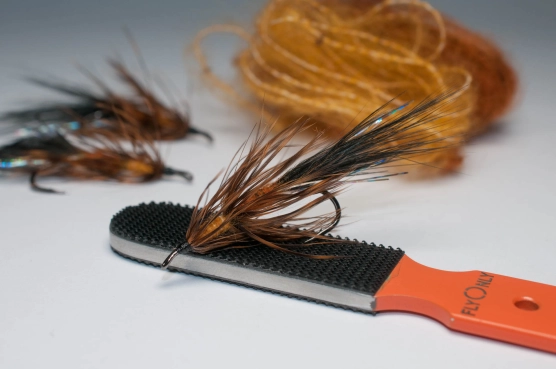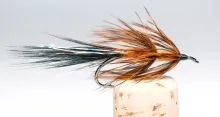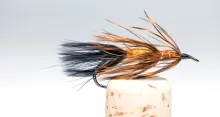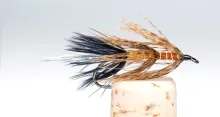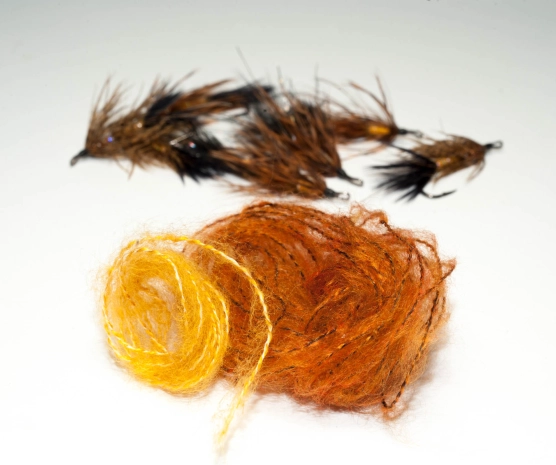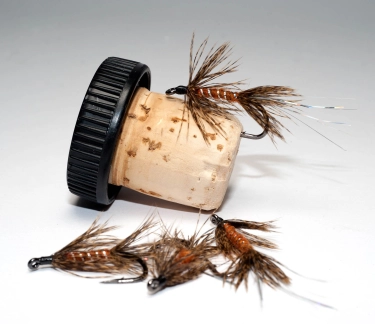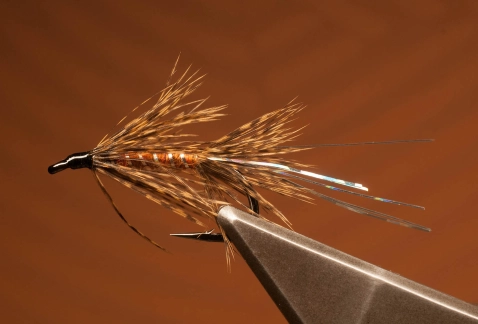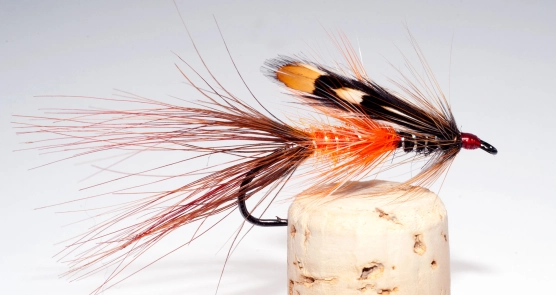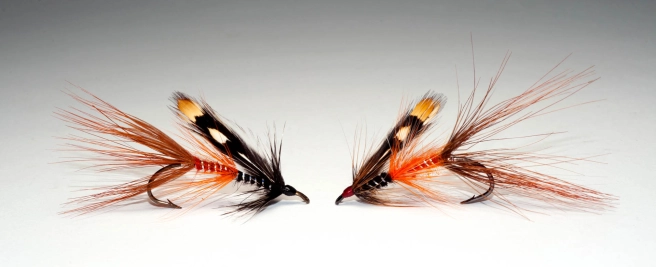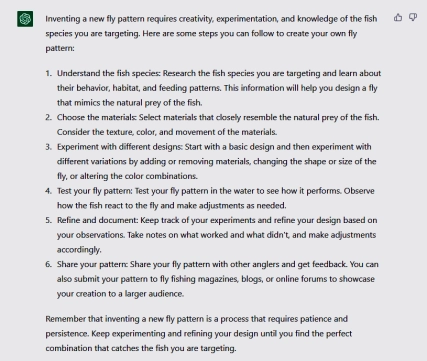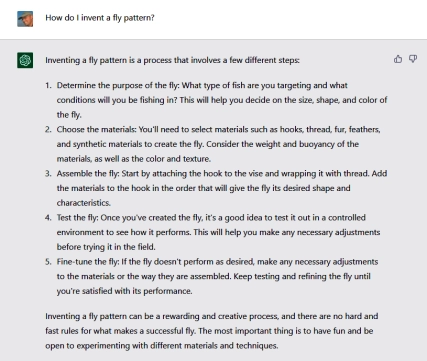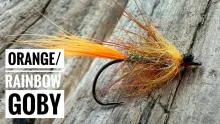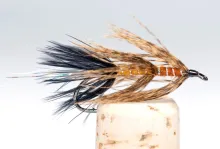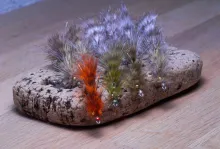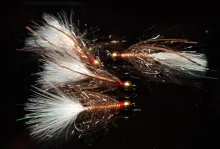Coming up with new fly patterns is essentially like coming up with new dishes: it’s basically impossible. Everything is a variation of a variation of something that has been made before - even The Yarn Thief
When it comes to tying known fly patterns, I like to be traditional, follow original recipes, adhere to the prescription and do as the tying instructions tell me to do with the materials it lists. I like to know that I tie a pattern like the originator envisioned it, and I am very much aware of when I stray away from the trodden path and add my own little variations to a fly.
But … I also like to improvise when I tie flies!
I bash together a few materials, mix some colors I like, add some eyes, a bead, some LCR. I use whatever is on the table, or in a nearby box or bag. And most of the time … I get some really lousy results!
Well, maybe not most of the time, but certainly often.
I play with various shapes, proportions, hues, textures and whatever comes to mind, and oftentimes it simply doesn’t work.
In the end of the article I ask an Artificial Intelligence how to invent a fly.
From meh to bad
“Tonight I want to tie a salmon pattern on a double hook. Yeah, what could go wrong? They always come out great!”
Well, not that night!
“A simple wet fly. Body, rib, front hackle. A guaranteed success!”
Albeit not always.
Sometimes my experiments come out kinda meh, and sometimes they just come out plain bad.
I don’t fish meh flies, and I absolutely don’t fish bad flies! The fish might not care, and go for both meh and bad, but such flies have no room in my flybox!
So there’s no pardon for them, and most of the time these flies simply wind up in the pile of meh and bad flies on my tying desk, and never travel any further, except maybe into a Ziploc bag and from there on to the elephant churchyard of flies.
But sometimes …
But it does happen – a little more than once in a blue moon – that an improvised fly leaves my vise that I consider worthy a dip in the wet element.
Some of them are just variations of well known and trusted patterns. Well, most of them to be honest. Omoe Brushes, Buggers, hair winged streamers, salmon tubes, Intruders.
Some of them are inspired by something I’ve seen in a book, magazine or online.
A few are inspired by a material that I found. A dubbing, a yarn, a nice color, a special texture or appearance, which just speaks to me, and inspires me.
They are new to me, but rarely to the world. A few have something not seen that often. None are revolutionary or groundbreaking.
So what?
Well, not much actually.
A lot of these flies pass unnoticed from my vise into my boxes – or to the meh and bad mausoleum as mentioned above.
A few may be elevated to a social media post and wind up on Facebook or Instagram, where they may receive some partially deserved accolade from my friends and followers there. Who doesn’t like basking in the pale rays of a few likes or thumbs up? It all boosts the fly tying ego, and that doesn’t have to be bad at all.
Some become stables in my fly box, many times developing a bit as I start using them and tying more of them. Flies mature.
I won’t say that I have been the father to many flies that people tie or recognize, but once in a while I see a pattern of mine being tied and quoted as being mine. Most of the time when I recognize something resembling a fly that I “invented”, it’s actually just because someone else “invented” the same fly by random coincidence – or sometimes accident. I mean a shrimp is a shrimp, a bugger a bugger and a colorful intruder is after all just a colorful intruder.
Move along! Nothing to see here!
|
|
|
|
The name game
I don’t like naming my flies. Some tyers name their flies before the varnish is dry, but I feel that a fly pattern has to prove its merit before earning a proper name.
It’s not like I have a hard time coming up with names. Having been a journalist and a writer for decades, I know my way around words, and being creative with them is fairly easy to me.
So the circumstances, the location, a color, a material or something else sets off a row of thoughts, and a fly becomes the Orange Trim or the One Mallard Shrimp.
Some names come as happy mishaps like typos or kludgy translations from Danish to English. Thus is born the Kluting or the Strange Christmas Tree
Some are simply just called what they are: Messy Pike Fly, The Terrible Muddler, Sea Trout CDC&Elk.
All these flies have deserved their names and have been baptized by fish many times.
I “invented” a fly
A Wednesday in December 2022 I tied a nice fly while being online via Zoom with a couple of virtual tying friends.
The fly was the result of me nicking some yarn from my darling wife, Birgitte, who was at the time knitting a beanie style cap for herself. She had a few bunches of yarn laying on our dining table, and a particular type caught my fly tying eye. A thin, light core was surrounded by an airy veil of loose, thin and soft wool. It looked like the perfect soft dubbing brush. It was there in two colors: a warm yellow and a rusty orange, and I spooled off a small bunch of each and brought into my tying room.
My plan was to tie a fly using it the coming Wednesday where I was attending the weekly online tying session that has been taking place among a group of Danes since almost the beginning of Covid.
I thought about doing a spider like fly with a simple ribbed body and a front hackle, but wound up with a basic idea of a fly divided into two by a central hackle, using the two different yarn colors on the body.
In other words a classic grub style fly, and a style that has been seen thousands of times in thousands of variations.
Come Wednesday
When the tying commenced, I’d dug out some other materials: a black Bird Fur skin – in other words a very marabouy hen skin with some really fluffy and soft feathers. I also had a grizzly hen skin dyed a warm yellowish orange, which seemed to match the colors of the yarn. A bag of silvery flash was on my table, so that was incorporated too.
The hook of choice was the beautiful bomber hook from Danish Ahrex. A size 2 gave some space for the sections and hackles.
I can almost tie these sectioned flies blindfolded, having tied hundreds of Omoe Brushes, Woolly Socks and other patterns with several hackles, so banging this one together was no challenge.
A black marabou tail with some flash was followed by a body section of the light yarn, then a wet fly style hackle and another body section, this one dark, and finally a soft front hackle.
So in other words a completely ordinary grub style fly, even in colors that have been seen many times before, and not exactly an invention.
Basking
I often post the results of these tying sessions online, and enjoy the brief attention that they generate. If nothing else I add a bit more fly tying to the social media, in a futile attempt to push away the cute kittens, people jumping trampolines and not least young girls with, let’s say certain frontally oriented advantages.
My fly posts mostly generate some likes and a few nice comments, and maybe a suggestion or two. So did this one.
I decided to spiff up the fly a bit and use a wrapped hackle for the tail to make it fluffier and better defined, and to add rib to the body, which always gives a nice accent to a fly. The ribbed body was inspired by the flies of Belgian Geert Werbrouck whose beautiful flies often feature multiple hackles and almost always have a rib, sometimes combined of several materials. Geert had kindly commented on the first fly.
So it was now in being tied its second version.
Onto social media again, and once again enjoying some more attention and a few comments.
This time one was from Dutch Bram Flierman, who suggested using partridge for the hackles in stead of hen.
The Third Yarn Thief
All my large partridge hackle had been eaten up by my March Brown project three years ago, so I had to fall back on the partridge dyed Brahma hen cape that I bought back then for the very purpose of being “large partridge”.
These Brahma feathers are an excellent substitute for the partridge, and even better in many ways, being numerous on the cape, consistent in size and barb length on the single feather and – not least – much softer in the stem than the partridge.
So another incarnation of the grub was tied in the same manner as the second version, but now using a black hackle for the tail and Brahma for the hackles.
I was pleased. Another SoMe-post told me that others were too, and much against my principles – but sparked by a suggestion in a comment from Danish angler Erik Tveskov and my own wordiness – the fly got a name: the Third Yarn Thief.
Third version of a fly tied with stolen yarn … yeah, you get it, right?
Did I invent a fly?
I put together some materials that I had, developed a bit on the pattern and matured it to a form that I liked, and did so with no recipe, but just improvising.
So I kinda did invent a fly pattern.
But then again I did nothing of the sort!
Look at an all classic Usk Grub, and you see the kinship. The Usk Grub and other grub flies have been tied in so many variations that it’s pretty hard to come up with a new one.
Speaking of the Usk Grub … is that an original fly. How about the Irish Shrimp? Which came first. They are so alike that one is almost bound to have inspired the other.
Or check out the Apache, one of the many other Shrimp style salmon flies.
I actually tied an improvised grub style fly some years back, and only later realized that it was almost perfectly identical to the Apache – which I didn’t think of for a moment while tying my fly.
Virtual friend Jason Klass commented online that my new fly reminded him of an Akroyd. Yup, the earthy colors and the warm yellow, that’s the Akroyd colors. I didn’t think of the Spey fly Akroyd when I tied it, but I can certainly see the likeness.
Danish angler and tyer Alan Overgaard mentioned both the grub style and the Danish fly Djihad, which this fly indeed looks a lot like – and which again looks like a classic grub fly.
Martin Joergensen
Martin Joergensen
Martin Joergensen
Good artists borrow, great artists steal
These words were uttered by Pablo Picasso – or maybe they weren’t. No one actually knows if they are truly his. Sometimes the saying is “Good artists copy, great artists steal”. Both the quote and the dispute lends itself fine to the fly tying world in an odd meta way. Even the origin of the quote is unknown, but attributed to a certain person.
Likewise with fly patterns.
As already mentioned, there are very few new flies seeing daylight, and tying an improvised fly or thinking for a long time and being creative is absolutely no guarantee that it’s going to be something new.
Being inspired by other flies is not illegal, and the number of flies with the word Variation in their name is countless.
Innovative fly tyers
The whole experience got me thinking about the concept of inventing a fly.
Very few new fly styles see the light of day nowadays. They have basically all been tied before. It requires some really innovative uses of techniques and materials to break the mold and come up with something that’s actually new or different.
Only few tyers do that these days. Look at tyers like Pop Popovics, Blane Chocklett, Oliver Edwards or Nick Thomas. They seem to be constantly on the lookout for new materials and techniques, and have all originated flies, which were markedly different from what was before.
We have also featured some pretty radical, but lesser known tyers on this site, like Malaysian Dron Lee, Russian Dmitri Tseliaritski, Australian Rob Meade, Canadian Bob Kenly or David Cowardin from the US, who all have broken barriers when they tie flies.
I talked to Chat-GPT about this
In the light of March 2023 being the "dawn of Artificial Intelligence" - or at least the time when AI really broke through, I thought it was suitable to bring the reply I got back in December when I asked Chat-GPT about its opinion.
I asked: How do I invent a fly pattern?
Well, don't expect innovation or brilliant ideas from the bot. It's not wrong, but it's kicking in a few open doors and not bringing much new to the table:
- Determine the purpose of the fly: What type of fish are you targeting and what conditions will you be fishing in? This will help you decide on the size, shape, and color of the fly.
- Choose the materials: You'll need to select materials such as hooks, thread, fur, feathers, and synthetic materials to create the fly. Consider the weight and buoyancy of the materials, as well as the color and texture.
- Assemble the fly: Start by attaching the hook to the vise and wrapping it with thread. Add the materials to the hook in the order that will give the fly its desired shape and characteristics.
- Test the fly: Once you've created the fly, it's a good idea to test it out in a controlled environment to see how it performs. This will help you make any necessary adjustments before trying it in the field.
- Fine-tune the fly: If the fly doesn't perform as desired, make any necessary adjustments to the materials or the way they are assembled. Keep testing and refining the fly until you're satisfied with its performance.
Inventing a fly pattern can be a rewarding and creative process, and there are no hard and fast rules for what makes a successful fly. The most important thing is to have fun and be open to experimenting with different materials and techniques.
Yeah, right! Get some materials, tie (assemble, sic!) a fly, try it out, adjust.
I love " Add the materials to the hook in the order that will give the fly its desired shape and characteristics." ... duh!
Well, it took an AI to be that smart, but it certainly doesn't teach you how to invent a fly more than it teaches you to cook or build an airplane.
I asked it again here in March, and the reply was different, but not much better.
- Log in to post comments

